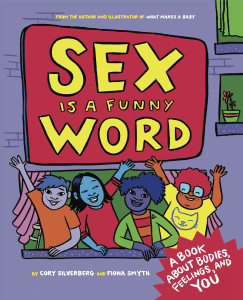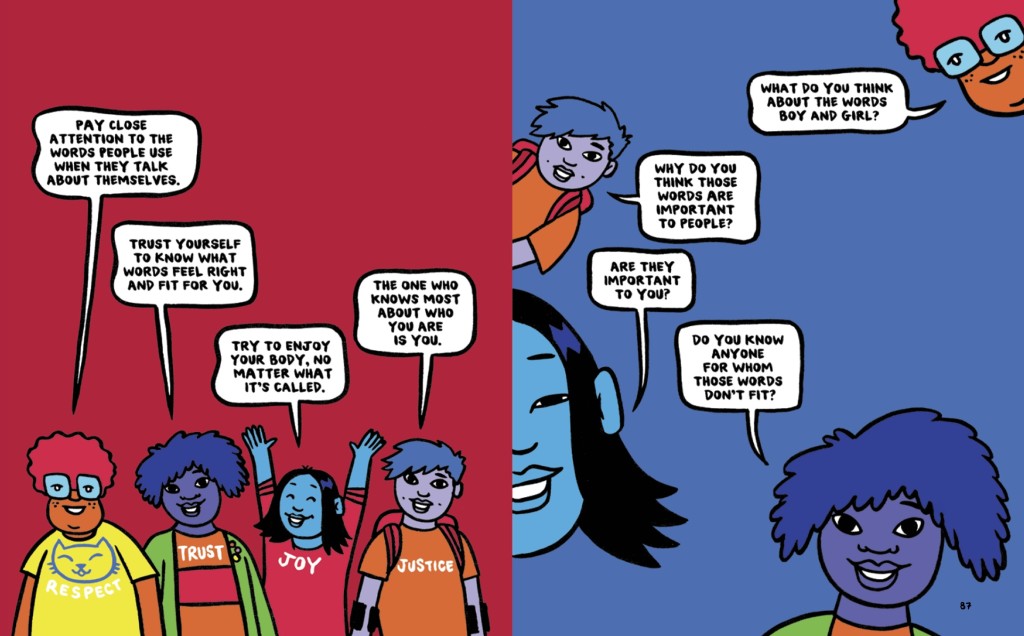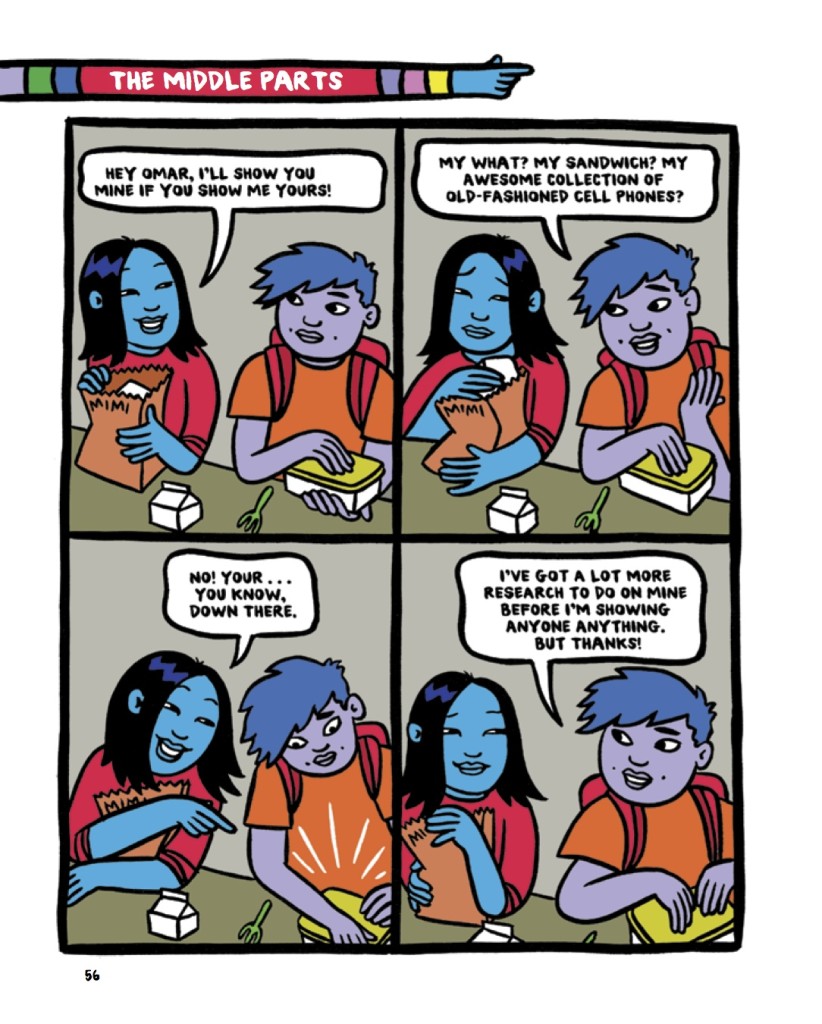 In 2012, I donated to a Kickstarter campaign for a little book called What Makes A Baby, which is STILL on the top of my list to recommend to parents. (You can see my blog post about it here.) To my utmost joy, author Cory Silverberg and illustrator Fiona Smyth have teamed up and put out a SECOND queer-friendly book, Sex is a Funny Word. To say I was blown away by this body-positive, queer-positive, sex education book is an understatement. Every kid should have this book in their home. It is beautiful and powerful and chock-full of information, presented in such a respectful and accurate way.
In 2012, I donated to a Kickstarter campaign for a little book called What Makes A Baby, which is STILL on the top of my list to recommend to parents. (You can see my blog post about it here.) To my utmost joy, author Cory Silverberg and illustrator Fiona Smyth have teamed up and put out a SECOND queer-friendly book, Sex is a Funny Word. To say I was blown away by this body-positive, queer-positive, sex education book is an understatement. Every kid should have this book in their home. It is beautiful and powerful and chock-full of information, presented in such a respectful and accurate way.
I was lucky enough to be able to interview Cory about the book. Interested in the book? You can buy it here or comment below with your favorite queer-friendly kid’s book for a chance to win a copy of Sex is a Funny Word!
Levi: Can you give us a brief overview of Sex is a Funny Word? What age are you aiming for with it? Is this book for queer kids only or everyone?
Cory: Sex is a Funny Word is geared to kids around 7-10 years old. That’s what we say, but the truth is that every kid is in a different place in terms of development, experience, curiosity, and needs. So the more precise way I describe the book is that it’s written for kids who aren’t yet near puberty.
The book is queer sex education, but it’s written for all kids and written and illustrated in a way to include every kind of kid and every kind of family. One thing that is unique about the book is that it doesn’t centre hetero-normative or gender-normative bodies or experience. It is inclusive of trans, queer, and intersex bodies and experience.
L: One thing that struck me from the very table of contents was the phrase “boys, girls, and the rest of us” to discuss gender. I love it so much. And that section isn’t simply one page—it breaks everything down slowly. Was this a driving point of the book? How did you settle on that phrase?
C: Yes, our desire to have a book that does gender differently, and better, was key as we started writing Sex is a Funny Word. There weren’t any sex ed books for kids that included kids who are gender non-conforming, gender diverse, trans, or simply not sure where (or if) they belong given the options they see in ways that didn’t feel tokenistic or pathologizing.

We use two different phrases in the book. In some parts we say there are “boys, girls, and the rest of us” and we also say that there are “boys, girls, and all of us.” The precise phrasing emerged in conversation with Morgan Holmes, who was an early reader of drafts of the book. Morgan is an academic, an educator, and a parent, and much of her early work is around intersex issues.
She and I were talking about the challenge of not wanting to reinforce a gender binary while at the same time being real about the fact that the binary is all some kids know. Even for those of us who don’t fit neatly into one category or another, its impact is profound and can’t be ignored.
So how do we talk about boys and girls without reinforcing the binary? How do we make sure kids know that those are only two of many ways we describe ourselves in relation to gender? It wasn’t going to work to make a long list of other gender identities. The list is too long, and kids would get bored. It would be English-centric (our first book has been translated into 7 languages already), and of course the words we use change all the time. We had to reference boys and girls, but we wanted to make it clear that they are not the poles that define gender, they are just two of many. So we chose this grammatical intervention of “the rest of us” suggesting the possibility that those of us who are usually thought of as “other” may very well be the bulk of us on this planet.
L: There’s a page that I really want to highlight. The text reads “Some people use the term private parts to describe parts of the body that have to do with sex. Because any part of your body can be private, in this book we…call them your middle parts, because they are in the middle part of your body. Just because we choose to keep our middle parts private and covered most of the time doesn’t mean they are bad. Our middle parts are beautiful. After all, they are parts of our bodies.”
I think I had to step away from my computer and have some feelings after read that page. I adore it—it speaks to the way that we create shame in our bodies from an early age. Can you speak to that and the decisions you made with regard to that subject?
C: It’s long been a sticking point for me that sex educators still use the term “private parts” when they are talking about genitals. It is a problem in several ways.
In terms of keeping kids safe, it makes no sense to tell them that the genitals are the only part of your body that should be private or that they get to say when and who touches them. Inappropriate touching and sexual abuse is not always genitally focused, and it often begins with other kinds of touch. So the better way to keep kids safe is to teach them about touch that feels okay and touch that doesn’t feel okay and encourage them to know they can always try and talk about it.

“Private parts” language for genitals also sends a message which we get throughout our lives that our sexuality is entirely in our genitals. This is 100% false, and it causes a lot of pain, anxiety, and grief as we struggle with our actual bodies, which are sexual in ways far more complicated than the messages about private parts suggests.
All of this is to say I knew I had to get rid of “private parts.” And I arrived on “middle parts” because that’s where they are, in the middle of the body.
L: I think one of the things that is unique about Sex is a Funny Word is the way that it deals with trans bodies and trans needs. Can you tell us about that?
C: I’m glad you’re calling out these two different aspects of what is missing in sex education. We need to be talking about bodies AND experience, and we need to acknowledge that our needs, desires, and experiences aren’t always easily categorized by what our body looks like. Our book is written for everybody (and every body) so it isn’t just about trans experience but trans bodies, which are visible in the book and as well as the trans experience. We do this in graphic ways; the section where we see pictures of genitals includes trans bodies, and we do it in the text by always talking about gender as an experience that is both personal and social. While we wrote the book for everyone, we were most interested in writing a book for kids who never see themselves in books. And that is especially true of kids who are gender non-conforming, gender diverse, and youth who are trans.
L: There’s something really amazing about Fiona Smyth’s illustrations. They’re cartoonish while still being obvious, relateable people. They’re all in beautiful colors, which takes away racial skintone and is also really eye-catching to look at. And that’s not to say that they’re racially neutral in any way (which so often means white-looking). How awesome is Fiona and how can we go about cloning them?
C: Yes, she is awesome! This is very much Fiona’s style in her painting, graphic design work, and her own books (before we started working together she published an amazing graphic novel called “The Never Weres“). What was important for us was that the characters aren’t gender neutral or racially ambiguous but that the book reflects the world we live in, and again that all kids can find themselves in the book.
L: Any school libraries carrying it, do you know? I want this in every high school. And middle school.
C: I’ve heard from some teachers who are using parts of the book in their classes, and I know of at least one school in New York that is using the book as a text book for its sex education classes. It’s in plenty of public libraries already which is encouraging. I don’t really know if the book is in any school libraries yet. I wouldn’t know how to find that out. I imagine that the title alone might make it a problem in the US, but I share your hope!
L: Thank you for taking the time to talk to us, Cory!
Buy this book for your kids, your friends’ kids, and your local libraries. Don’t forget to comment below with your favorite queer kid’s book to earn a chance to win a copy! We’ll select a winner on Monday, November 2.
The post Sex is a Funny Word: Interview and Giveaway appeared first on VillageQ.














